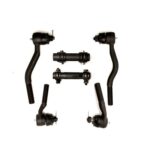It’s a question that might cross your mind as you’re driving down the road or performing maintenance: just how many parts make up the vehicle you depend on every day? The answer might surprise you. When you consider every component, down to the smallest nuts and bolts, the average car is estimated to have around 30,000 parts. However, if you categorize larger assemblies as single parts, the number is closer to 1,800 separate components. Even a seemingly singular unit like the engine is a complex assembly containing thousands of individual pieces itself. These parts are sourced from various suppliers and the vehicle manufacturer, coming together in a complex orchestration of engineering and manufacturing.
The Sheer Number of Car Parts: A Detailed Look
To truly grasp the complexity, consider that assembling these thousands of parts requires significant effort. An average car needs up to 4,800 welds to join its many components into a cohesive structure. The assembly process in a modern factory can take around 19 hours for a single vehicle. Modern car production is a marvel of efficiency, with massive plants employing robots, automated tracks, and large workforces. In a single day, a contemporary car factory can produce approximately 1,450 cars. This is a stark contrast to the early days of automotive manufacturing, where a production run of a classic car might only total a few hundred units, as exemplified by the rare 1970 Plymouth Hemi Superbird, of which only 135 were ever made.
Identifying Basic Car Parts
For the everyday driver, understanding the main systems and components of your car can be incredibly helpful. When you open the hood, several key parts are readily visible. Naturally, the engine is the most prominent, but you should also be able to locate the battery, radiator, air filter housing, and, if equipped, the air conditioning compressor and various fluid reservoirs for brake fluid, coolant, and windshield washer fluid. On some models, the alternator might also be easily seen.
Moving to the wheel area, you can identify components related to the suspension and braking systems. Visible parts often include the shock absorbers or struts, the brake calipers and rotors, and the axles. Axles are crucial for transferring power from the engine to the wheels; issues with axles can manifest as loud clunking noises or unusual vibrations while driving.
Other essential parts, like the muffler and transmission, are located underneath the vehicle. The muffler, part of the exhaust system, is typically positioned between the engine and the tailpipe at the rear of the car. A damaged muffler, showing cracks or corrosion, can lead to reduced engine performance and increased noise.
The location of the transmission depends on the vehicle’s drivetrain. In front-wheel-drive cars, the transmission is usually situated behind the engine, integrated with the front axle assembly. In rear-wheel-drive vehicles, the transmission is directly connected to the back of the engine, sending power to the rear axle.
Exploring Main Engine Components
The engine is the heart of your vehicle, a complex machine comprised of numerous interconnected parts working in harmony. An exploded view of an engine reveals key components such as the cylinder head cover, cylinder head gasket, distributor (in older vehicles), cylinder head, exhaust manifold, camshaft pulley, oil filter, water pump, oil pan, engine block, and timing belt drive pulley, among many others.
The materials used in engine construction have evolved over time. Modern vehicles commonly utilize engine blocks made from aluminum or aluminum alloys. However, classic cars often feature engine blocks made of cast iron. Cast iron was favored historically for its cost-effectiveness and availability, as well as its ability to be cast into complex shapes with precise cylinder alignment. However, cast iron is significantly heavier than aluminum, impacting vehicle weight and fuel efficiency. General Motors pioneered the use of aluminum engines in the early 1960s, with the Buick Special being among the first cars to feature a lightweight 215-cubic-inch V8 engine with a full aluminum block and heads. Despite the advantages of aluminum, cast iron remains relevant today due to its lower cost and superior thermal stability in certain applications.
Finding Parts for Maintenance and Restoration
Whether you are maintaining a modern car or restoring a classic, locating the necessary parts is essential. For classic car enthusiasts, specialized suppliers like Collectors Auto Supply are invaluable resources for sourcing classic auto parts. Beyond specialized suppliers, salvage yards, automotive swap meets, car shows, and classic car clubs can also be excellent places to find needed components. The availability of parts can vary depending on the popularity and production numbers of specific classic car models. Interestingly, some parts may be interchangeable across different models from the same manufacturer, expanding your options when searching for specific components.
In conclusion, the sheer number of parts in the average car underscores the incredible complexity of these machines. From the thousands of tiny fasteners to the large and intricate engine components, each part plays a vital role in the vehicle’s overall function and performance. Understanding the basic systems and components, and knowing where to source parts, is beneficial for car owners and enthusiasts alike.
